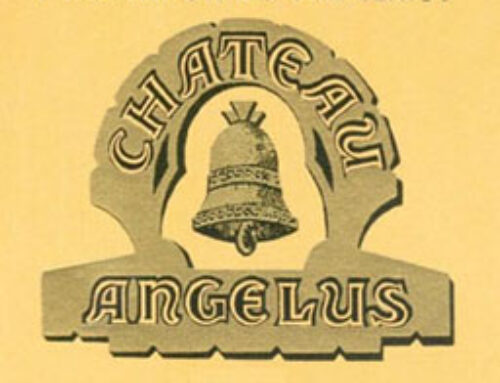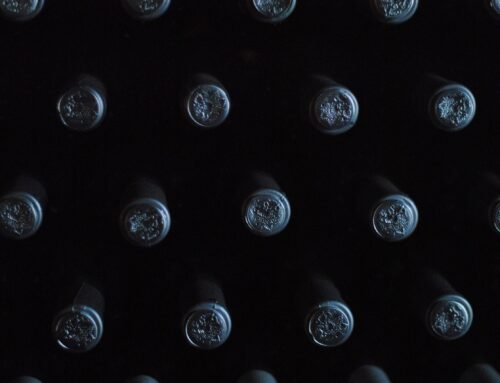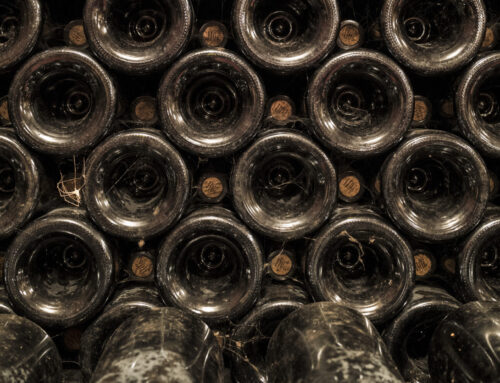Champagne is wine. When it comes to wine, time is a topic that not only has outstanding significance but also often divides opinions. A hotly debated point is whether a wine is in the right drinking window and thus provides the greatest possible enjoyment.
Time also plays an immensely important role with champagne. To discuss this, let’s start from the beginning:
First, Champagne is no different from any other wine in terms of production, because as a still wine, it too undergoes an initial fermentation. The result is the so-called “vin claire”. Whether it is then subjected to malolactic fermentation (conversion of malic acid into milder lactic acid) is decided by the winemakers. However, this process often happens on its own. Some deliberately want to avoid it because they believe Champagne is much fresher without malolactic fermentation. What is commonplace today was the exception before the 1960s and most winemakers did without it. (Champagne, Peter Liem, 2017, p. 49.).
Afterward, the still wine goes off into the bottle, where it then mutates with the yeast and a little sugar into the champagne with bubbly as we know it. For non-Vintage or NV Champagne, the law in France provides a minimum storage period of 15 months, and for vintage Champagne a Minimum of 36 months. There are no upper limits. A Dom Perignon Œnotheque can wait well for even 30+ years for its Degorgement (removal of the yeast in the bottleneck).
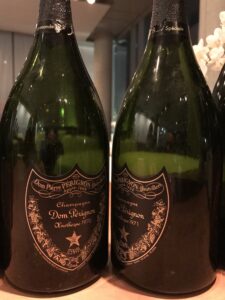
Œnotheque from 1970 and 1971, drunk a few years ago.
One of the two (I mean 1970) had been disgorged in 2010. Fresh and impressive it was and the age was not even close. (c) by Marc von Harten
However, before the ripening and the subsequent degorgement, it still needs some working steps, which I explain in detail here:
Liqueur de tirage
A mixture of wine, sugar, and yeast, the liqueur de tirage, is added to the still wine. This begins the second fermentation in the bottle. This sounds simple, but it is not. Because the yeast must be strong enough to start a second fermentation. Since the wine at this stage already has around 11 percent alcohol, it is not easy for the yeast to get going. Alcohol, after all, is the yeast’s natural enemy. With increasing volume percentages, the yeast cells die. In the past, people probably thought “a lot helps a lot” and added a good portion of sugar to the yeast to help it get started. The result was partly devastating, but more on that in a moment. Today, we know a bit more, among other things, that 4 grams of added sugar bring 1 bar of pressure into the bottle.
Prise de mousse
The yeast consumes the sugar and transforms it into alcohol and carbon dioxide (mousse). Logically, the latter cannot escape from the sealed bottle. In the past, this led to a large part of the Bouteille literally exploding due to too much pressure and flying around the ears of the people present. This was one reason why champagne was rare and expensive back then. Some bottles had a “chain mail” on to minimize the risk of injury when exploding because one was simply not yet able to produce stable bottles.
Over time, the alcohol content increases by another 1 to 2 percent by volume. This fermentation in the bottle is, the core méthode Champenoise.
The méthode Champenoise often takes place sur lattes. This refers to the storage of the bottles in a horizontal position, formerly on wooden slats. This fermentation takes longer compared to alcoholic fermentation in still wine, partly due to the rather cooler temperatures in the deep cellars of Champagne. It is said to be completed only after a month (and more).
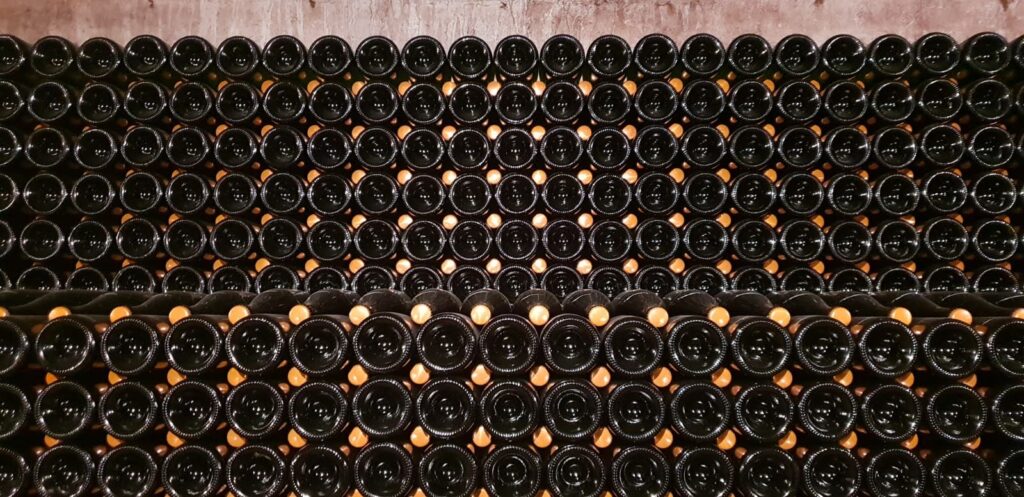
Champagne bottles “sur lattes” during storage (c) weinkellerschweiz.ch
One might think that this is it. But this is wrong because, during the following maturation period in the bottle, a lot happens.
The initial pressure in the bottle is usually around 6 bar with an original sugar quantity of 24 grams. For comparison, a car tire has about 2.5 bar. During the months of bottle aging, the pressure steadily decreases and the bubbles go from coarse bubbles to delicate and fine bubbly.
After 10 years or more, the pressure in the bottle drops to about 4 bars or less. Incidentally, there is a process in Champagne, which is now hardly ever used, in which less sugar is added to the bottle from the outset and thus only 3 to 4 bars of pressure. This clearly affects the taste ̶ but that is another topic.
During this phase of wine aging, important autolysis occurs. The yeast slowly dies and enzymes get to work. They feast on the dead yeast cells. This affects the aroma, texture, and body of the champagne. Research has shown that the decomposition of yeast cells through autolysis also has a positive effect on longevity (Champagne, The Future Uncorked, Gert Crum, 2017, p. 73). The dead yeast probably acts as an antioxidant and thus makes the wine last longer, which in turn offers longer enjoyment. But here, too, everything must be brought into a reasonable balance, because very long storage does not automatically guarantee a bottle of perfect, long-lasting champagne.
In the case of champagnes that are stored for longer, i.e. 8 years or more, before degorgement, one often brings the bottles from the horizontal to a completely vertical position. This storage sur pointes reduce the contact between yeast and wine to a minimum.
And this yeast storage in the bottle has a very special meaning with regard to the finished product because it contributes significantly to the shelf life and taste after disgorgement. The wine also becomes more complex, to which the finer mousseux should also contribute.
Such storage is an economically important factor for many smaller houses. A wine that is not (yet) sold does not bring in any money. Many smaller winemakers make a virtue out of necessity and carry out several degorgements within a vintage so that they can sell it in stages. I had the experience that champagne with four degorgements tasted completely different four times. The freshest and therefore most beautiful wine was the one with the latest degorgement. In this context, I have often heard that champagnes that have matured longer in the bottle require less shipping dosage. I can confirm this insofar as that in my experience even good BSA (Brut sans année, i.e. NV-Champagnes) with little dosage but only 3 to 5 years bottle maturity after degorgement are not “forever” durable, but exceed their zenith after about 5 years. We will come to the dosage below.
A few weeks before degorgement, the rémuage begins. Bottles that are not already sur pointes, but are still horizontal, are prepared for degorgement by slowly moving them from horizontal to vertical. This allows the dead yeast to be positioned in the neck of the bottle for disgorgement.
Today, this is mostly done automatically with so-called gyropalettes. However, there are still some winemakers and also larger houses that have this done by hand by a so-called remueur, at least for their prestige wines.
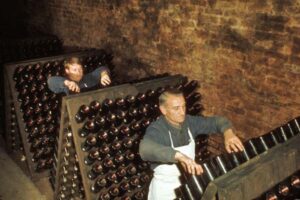
Remuage bei Moet Henessy
Now we finally come to the already often mentioned degorgement. This is usually no longer done by hand à la volée, but by machine. The necks of the bottles are immersed in -27 degree cold water mixed with glycol, or more ecologically recently, in a liquid based on propanediol, and then opened. Due to the overpressure in the bottle, the sediment shoots out and a clear wine remains. Since a small part of the champagne is now missing from the bottle, the wine receives the so-called dosage, a certain amount of sugar dissolved in wine. This amount of sugar is responsible for the sweetness level and thus the name of the champagne. Depending on the winemaker, this is handled differently and is often a well-kept secret. Depending on the amount added, one speaks of Zero Dosage or Brut Nature (0 grams of sugar), Extra Brut (0 to 6 grams), Brut (6 to 12 grams) up to Doux, where 50 grams of sugar are permitted.
The dosage has crucial importance because with it you can not only let a wine run up to its best form but also simply ruin it by getting it out of balance. It is also clear that sugar can be used to mask many things. Some winemakers want to emphasize the expression of their Champagne by bottling it with no or very little dosage. There are now many great examples here that paint a great picture of their terroir.
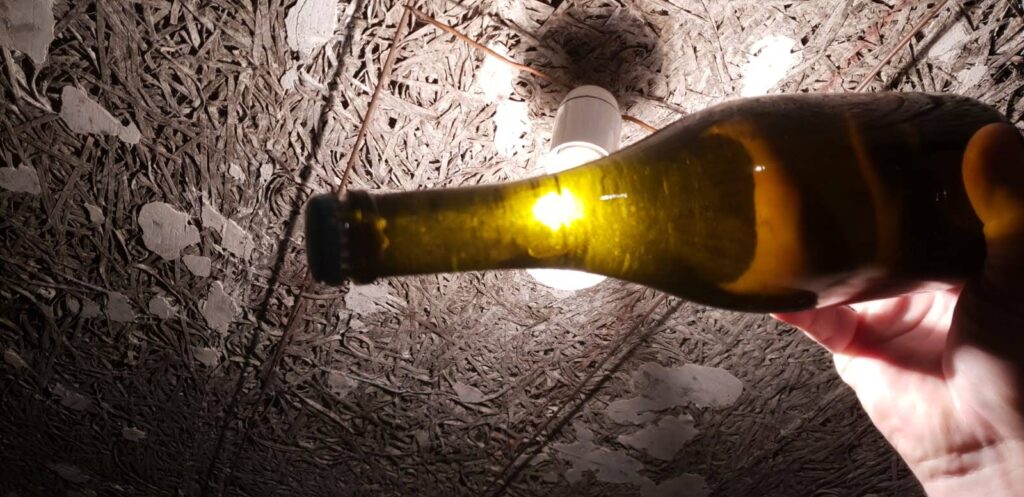
On the left of the crown cork, the yeast stopper is clearly visible before degorgement. (c) weinkellerschweiz.ch
Finally, the bottle is closed with the cork. But even if the Champagne is now ready for sale, it is not necessarily ready to drink immediately. There are winemakers such as Anselm Selosse, for example, who even write on the bottle that you should wait at least 6 months after degorgement with drinking so that the champagne can reach its equilibrium. So the wine continues to age. If you have several bottles of the same champagne, you will notice that its taste changes over time. Even with BSA, there is an ideal drinking window after degorgement, which is usually not in the first 6 months. So my general advice is to also store Champagne in a cool place for at least six to twelve months. Wine storage cabinets or one’s own wine storage with stable temperatures are suitable for this.
So, how do you drink it now? Almost quite simple!
I think it stands to reason that the flavor of champagne changes with storage time, as well as with the amount and size of the bubbles, as their texture affects the nose and palate.
The bubbles in champagne release the flavors by bursting on the surface. Therefore, glasses with too narrow openings, such as the unfortunately common flûtes, should not be used. The resulting concentration of the bubbles can quickly be perceived as disturbing in the nose and it does not correctly reflect the aromas.
A glass of champagne has about 2 million bubbles (Uncorked, The Science of Champagne, Comte Liger-Belair, 2004, p. 39). These can be allowed a larger surface area. After all, it’s wine, and with still wines, you wouldn’t think of drinking them out of a narrow glass, would you?
Personally, I like to drink champagne in large glasses, such as the Bordeaux glasses from Zalto or Sophienwald. That’s the best way for the wine to unfold. And if it goes more in the direction of opulence and matured champagne, I recommend a Burgundy glass. This allows the wine to develop fully.


